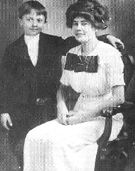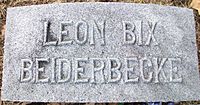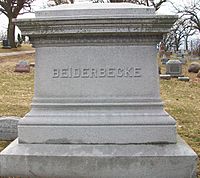Bix Beiderbecke facts for kids
Quick facts for kids
Bix Beiderbecke
|
|
|---|---|
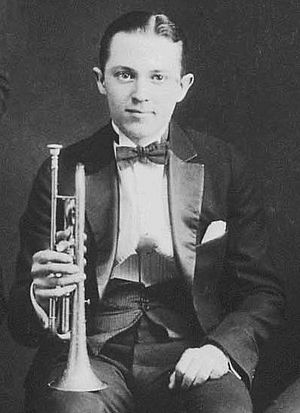
Beiderbecke c.1924
|
|
| Background information | |
| Birth name | Leon Bismark Beiderbecke |
| Born | March 10, 1903 Davenport, Iowa |
| Died | August 6, 1931 (aged 28) Sunnyside, Queens, New York |
| Genres | Jazz Dixieland |
| Occupation(s) | Musician, Composer |
| Instruments | Cornet, Piano |
| Years active | 1924–31 |
| Labels | Columbia/Okeh/Victor |
| Associated acts | Paul Whiteman, Jean Goldkette, Hoagy Carmichael |
Leon Bismark "Bix" Beiderbecke (born March 10, 1903 – died August 6, 1931) was an American jazz musician. He was famous for playing the cornet and piano, and also for composing music.
Bix Beiderbecke was one of the most important jazz soloists in the 1920s. He played the cornet with a unique, clear sound. People said his sound was like "shooting bullets at a bell." His solos on songs like ""Singin' the Blues"" and "I'm Coming, Virginia" (both from 1927) showed his amazing skill at improvising. This helped create the jazz ballad style, where solos are a key part of the song.
Bix also used special chords and could improvise freely with both melodies and harmonies. This influenced jazz music that came much later. "In a Mist" (1927) is his most famous piano song, and it's the only one he recorded. His piano style mixed jazz with classical music, especially Impressionist styles.
Bix was born in Davenport, Iowa. He taught himself to play the cornet mostly by ear. This led him to use a special way of holding his fingers, which made his style unique. He first recorded with a jazz band called The Wolverines in 1924. Later, he played with the Jean Goldkette Orchestra and then with Frankie "Tram" Trumbauer.
In 1926, Bix and Trumbauer joined Goldkette's main band. They toured a lot and even played against the famous Fletcher Henderson Orchestra in New York City. Bix made his most important recordings in 1927. After the Goldkette band ended, Bix and Trumbauer joined Paul Whiteman and his Orchestra, which was America's most popular dance band.
Bix's most influential recordings were made during his time with Goldkette and Whiteman. He also recorded music under his own name and with Trumbauer. He left the Whiteman band in 1929. Bix died in his apartment in Sunnyside, Queens, New York in the summer of 1931, when he was only 28 years old.
His early death made him a jazz legend. People saw him as a Romantic hero, like the "Young Man with a Horn" in a famous novel and movie. His life was often shown as a jazz musician who had to change his art for money. Bix remains a topic of discussion among experts about his life and his important contributions to jazz.
He played or composed many jazz classics like "Davenport Blues", "In a Mist", "Copenhagen", "Riverboat Shuffle", "Singin' the Blues", and "Georgia on My Mind".
Contents
Early Life
Bix Beiderbecke was born on March 10, 1903, in Davenport, Iowa. His parents were Bismark Herman Beiderbecke and Agatha Jane Hilton. There is some debate about his full first name, but his parents called him Bix, which he seemed to prefer.
Bix's father was a successful coal and lumber merchant. His mother played the organ at church and encouraged Bix's interest in the piano.
Bix was the youngest of three children. He started playing piano when he was only two or three years old. His sister remembered him playing with his hands over his head because he was so small. When he was seven, a local newspaper called him a "musical wonder!"
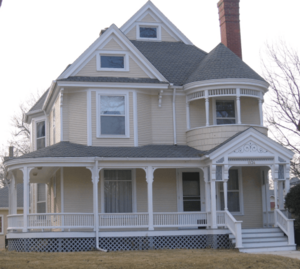
His brother, Burnie, recalled that Bix would often go to the riverfront to play the calliope on excursion boats. A friend remembered that Bix would rush home after movies to play the melodies he heard the accompanist play.
In late 1918, Burnie brought home a Victrola phonograph with jazz records. Bix loved the "hot jazz" he heard, especially from the Original Dixieland Jazz Band. He taught himself to play the cornet by listening to Nick LaRocca's playing. He also listened to jazz from riverboats that stopped in Davenport.
Bix attended Davenport High School from 1918 to 1921. During this time, he played with different bands. In 1920, he performed at a school event, singing and playing his cornet. He tried to join the musicians' union but failed a sight-reading test.
In September 1921, Bix went to Lake Forest Academy, a boarding school near Chicago. While there, he often visited Chicago to hear jazz bands in clubs and speakeasies. He sometimes played with the New Orleans Rhythm Kings. He also went to the South Side to hear black jazz bands like King Oliver's Creole Jazz Band, which featured Louis Armstrong. Bix once wrote to his brother, "I'd go to hell to hear a good band."
Bix often broke school rules, staying out past curfew. In May 1922, he was caught trying to sneak back into his room. He was expelled because of his poor grades and rule-breaking. Soon after, Bix decided to become a full-time musician.
He returned to Davenport briefly in the summer of 1922. Then he moved to Chicago and joined the Cascades Band, playing on Lake Michigan boats. He played gigs around Chicago until the fall of 1923, sometimes returning home to work for his father.
Career
The Wolverines
Bix joined the Wolverine Orchestra in late 1923. This seven-man group played "hot jazz" and avoided "sweet music." They named themselves after one of their favorite songs, "Wolverine Blues." During this time, Bix also took piano lessons and learned about classical composers like Eastwood Lane. Lane's music influenced Bix's piano style, especially on his song "In a Mist."
On February 18, 1924, the Wolverines made their first recordings. They recorded "Fidgety Feet" and "Jazz Me Blues." Bix's solo on "Jazz Me Blues" showed a new and important sound in jazz.
The Wolverines recorded 15 songs for Gennett Records in 1924. These recordings showed Bix's strong cornet talent. His playing had improved greatly.
Bix's playing was unique, but he also learned from other musicians. He listened to Dixieland jazz, the "hotter" Chicago style, and even classical music by Claude Debussy and Maurice Ravel.
Compared to Louis Armstrong, Bix played differently. Armstrong was a master of his instrument and often played high notes. Bix stayed in the middle range, focusing on melody and harmony rather than showing off. Armstrong was influenced by the blues, while Bix was influenced by classical composers.
Bix found a good friend and musical partner in Hoagy Carmichael. Carmichael was a law student and aspiring musician. He invited the Wolverines to play at Indiana University in 1924. On May 6, 1924, the Wolverines recorded "Riverboat Shuffle", a song Carmichael wrote for them.
Jean Goldkette's Orchestra
In late 1924, Bix left the Wolverines to join Jean Goldkette and his Orchestra in Detroit. However, Bix's time with Goldkette was short. The record company, Victor, didn't like Bix's modern jazz style. Also, Bix had trouble reading complex music scores. After a few weeks, Bix and Goldkette decided to part ways, but they stayed in touch. Goldkette told Bix to practice reading music.
A few weeks later, Bix recorded with some Goldkette band members under the name Bix and His Rhythm Jugglers. On January 26, 1925, they recorded "Toddlin' Blues" and Bix's own song, "Davenport Blues". "Davenport Blues" became a jazz classic.
In February 1925, Bix briefly attended the University of Iowa. He wanted to study only music, but his advisor made him take other subjects. Bix started skipping classes and was soon expelled.
That summer, Bix played with friends at a lake resort in Michigan. This band was also run by Goldkette. There, Bix reconnected with C-melody saxophone player Frankie Trumbauer. They became very close friends, both personally and musically. Trumbauer often looked out for Bix. When Trumbauer formed a band for a long stay at the Arcadia Ballroom in St. Louis, Bix joined him. There, he also played with clarinetist Pee Wee Russell, who said Bix made everyone play better.
In spring 1926, Bix and Trumbauer joined Goldkette's main dance band. They played at a resort in Indiana and at Detroit's Graystone Ballroom. In October 1926, Goldkette's band, called the "Famous Fourteen," played against the Fletcher Henderson Orchestra in New York City. Goldkette's band was declared the winner. Rex Stewart, Fletcher's lead trumpeter, said listening to Bix and his band was "most humiliating." Later, Fletcher Henderson's Orchestra recorded "Singin' the Blues" with Rex Stewart playing a solo that copied Bix's famous solo.
Even though the Goldkette Orchestra recorded many songs, most of them didn't feature Bix's famous solos. The record company wanted more commercial, popular music. However, Bix and Trumbauer also recorded under their own names for the OKeh label. Bix played some of his best solos with Trumbauer's band, starting with "Clarinet Marmalade" and "Singin' the Blues" on February 4, 1927. A few days later, he recorded two more important solos on "I'm Coming, Virginia" and "Way Down Yonder in New Orleans". Bix also helped write "For No Reason at All in C". He played both cornet and piano on that song. In September, he played only piano for his recording of "In A Mist". This was a very successful year for Bix.
In September 1927, Goldkette's main band closed down. Paul Whiteman wanted to hire Goldkette's best musicians. Bix and Trumbauer joined Whiteman's orchestra in Indianapolis on October 27.
Paul Whiteman's Orchestra
The Paul Whiteman Orchestra was the most popular and highest-paid dance band of its time. Even though Whiteman was called "The King of Jazz," his band played a mix of jazz and classical music for a wide audience. Whiteman was famous for performing George Gershwin's Rhapsody in Blue in 1924.
Some people have criticized Whiteman for not giving Bix enough chances to play jazz. They felt that Whiteman's focus on business hurt Bix's artistic freedom.
Bix is featured on several Whiteman recordings, including "From Monday On," "Back In Your Own Back Yard," "You Took Advantage Of Me," "Sugar," "Changes," and "When." These songs had special arrangements that highlighted Bix's amazing improvising skills. Bill Challis, an arranger, often wrote music specifically for Bix. Bix also played on popular hit records with Whiteman, like "Together," "Ramona," and "Ol' Man River," which featured Bing Crosby singing.
In February 1929, Bix returned home to Davenport to rest. The local newspapers called him "the world's hottest cornetist." He then spent the summer with Whiteman's band in Hollywood for a new movie, The King of Jazz. By September, he was back in Davenport, where his parents helped him get treatment. He spent a month at the Keeley Institute in Illinois.
While Bix was away, Whiteman famously kept his chair open in the band, hoping he would return. However, when Bix came back to New York in January 1930, he didn't rejoin Whiteman's band and played very little. His last recording session was on September 15, 1930, in New York. He played on the original recording of Hoagy Carmichael's new song, "Georgia on My Mind". This song later became a jazz and popular music classic. In 2014, the 1930 recording of "Georgia on My Mind" was added to the Grammy Hall of Fame.
Bix's playing also influenced Hoagy Carmichael as a composer. One of Carmichael's songs, "Stardust," was inspired by Bix's improvisations. Bing Crosby, who sang with Whiteman, also said Bix was a big influence.
After the Wall Street Crash of 1929, the music industry slowed down, and it was harder to find work. For a while, Bix's only regular income came from playing on a radio show called The Camel Pleasure Hour. However, during a live broadcast on October 8, 1930, Bix had trouble playing his solo. A fellow musician recalled that his "mind went blank." Bix spent the rest of the year at home in Davenport. In February 1931, he returned to New York one last time.
Death
Bix Beiderbecke died in his apartment in Sunnyside, Queens, New York, on August 6, 1931. It had been a very hot week, making it hard to sleep. Bix, who had trouble sleeping, played the piano late into the evenings. On the evening of August 6, his rental agent heard noises from Bix's apartment.
The official cause of death was lobar pneumonia, a serious lung infection. Bix's mother and brother traveled to New York to bring his body home to Davenport. He was buried there on August 11, 1931, in the family plot at Oakdale Cemetery.
Legacy and Influence
During his lifetime, Bix's unique playing was noticed more by critics in Europe than in America. A British music magazine, "Melody Maker," praised his cornet playing. In 1927, bandleader Fred Elizalde called him "the greatest trumpet player of all time."
After his death, the French jazz writer Hugues Panassié wrote an important article about Bix in October 1931.
The critic Otis Ferguson wrote articles that helped bring attention back to Bix's music and life. Ferguson wrote that Bix "lived very briefly […] in what might be called the servants' entrance to art." The idea of a talented jazz musician who dies young, like Bix, became a common theme in jazz history.
Bix's friends, like Hoagy Carmichael and Eddie Condon, wrote memoirs that painted him as a tragic genius, similar to famous classical composers like Ludwig van Beethoven. They described his pure tone and unique style. Eddie Condon famously said Bix's cornet sounded "like a girl saying yes."
In 1938, Dorothy Baker wrote the novel Young Man with a Horn, inspired by Bix's music. This story of a talented but troubled trumpet player helped shape how people viewed Bix. In 1950, a movie based on the book was made, starring Kirk Douglas and Doris Day.
Bix Beiderbecke still has a big impact on his hometown of Davenport, Iowa. There's an annual Bix Beiderbecke Memorial Jazz Festival, a "Bix 7" road race, and many Bix-themed items. In 1977, Bix's childhood home was added to the National Register of Historic Places.
A 1981 documentary film, "Bix: 'Ain't None of Them Play Like Him Yet'," featured interviews with people who knew and worked with Bix. His music was also used in three British TV shows in the 1980s. In 1991, an Italian director made a film called Bix: An Interpretation of a Legend, partly filmed in Bix's old home.
Today, Bix Beiderbecke is recognized as a very important innovator in early jazz. Many jazz cornet players still try to play in his style. In 2003, a plaque was put up in New York where he died, to honor him. That same year, a novel called 1929 was published, based on Bix's life. Jazz critic Digby Fairweather said that Bix, along with Louis Armstrong, was one of the most important "fathers" of the jazz cornet.
Music Style and Influence
Early jazz music often featured many instruments playing together. But by the 1920s, jazz solos became longer and more complex. Bix Beiderbecke and Louis Armstrong were key figures in this change. They are considered "the two most influential figures in the early history of jazz."
Bix's cornet style is often compared to Armstrong's. Armstrong was a master of his instrument and played with great skill. Bix taught himself to play, and his unique way of playing was clear in his music. While Armstrong often played high notes, Bix stayed in the middle range, focusing on exploring the melody and harmonies. Armstrong was influenced by the blues, but Bix was also influenced by classical composers like Debussy and Ravel.
Bix's most famous solo is on "Singin' the Blues," recorded on February 4, 1927. It's known as an important example of the "jazz ballad style"—a gentle, sweet, but strong piece played at a slow or medium speed. This relaxed style hinted at what would become "cool jazz" in the 1950s. "Singin' the Blues" is also famous because its improvisations sound carefully planned, with each musical phrase building on the last.
Jazz historian Ted Gioia noted that Bix's self-taught style led him to use an "unusual, dry embouchure" (how he shaped his lips to the instrument) and "unconventional fingerings." Gioia also pointed out Bix's "stubbornness," which made him stick to the cornet instead of switching to the trumpet, like many other musicians did. Bix's playing had precise timing, a relaxed delivery, and a pure tone. This was different from the "rough-edged sound" of King Oliver and Armstrong.
Bix's playing, both on cornet and piano, greatly affected other musicians. Eddie Condon said Bix's piano playing was amazing and "an entirely new set of sounds." Hoagy Carmichael said trying to explain Bix's music was like trying to describe a dream.
Musician Mezz Mezzrow described Bix's tone: "I have never heard a tone like he got before or since. He played mostly open horn, every note full, big, rich and round, standing out like a pearl, loud but never irritating or jangling."
"Jazz Me Blues," recorded with the Wolverines in 1924, is seen as very important for understanding Bix's style. Even though it was one of his earliest recordings, his unique playing was already clear. Trumpeter Randy Sandke said that in Bix's best solos, "every note is spontaneous yet inevitable."
Bix also played piano on recordings like "Big Boy" (1924), "For No Reason at All in C" (1927), and "Wringin' and Twistin'" (1927). His only solo piano recording was "In a Mist" (1927). His piano playing showed the same unique fingerings, focus on harmonies, and connected musical phrases as his cornet playing. These new harmonies in his music pointed the way to future jazz styles like bebop.
Compositions
Bix Beiderbecke wrote or co-wrote six instrumental songs:
- "Davenport Blues" (1925)
- "In a Mist (Bixology)" (1927)
- "For No Reason at All in C" (1927) with Frank Trumbauer
- "Candlelights" (1930)
- "Flashes" (1931)
- "In the Dark" (1931)
"Candlelights," "Flashes," and "In the Dark" are piano songs that were written down with help from Bill Challis, but Bix never recorded them.
Major Recordings
- Bix Beiderbecke's first recordings were with the Wolverine Orchestra
- "Fidgety Feet" / "Jazz Me Blues", recorded on February 18, 1924
- "Copenhagen", recorded on May 6, 1924
- "Riverboat Shuffle" / "Susie (Of the Islands)", recorded on May 6, 1924
- As Bix Beiderbecke and his Rhythm Jugglers
- "Toddlin' Blues" / "Davenport Blues", recorded on January 26, 1925
- With the Jean Goldkette Orchestra in 1926–27
- "Sunday", recorded on October 15, 1926
- "My Pretty Girl" / "Cover Me Up with Sunshine", recorded on February 1, 1927
- "Sunny Disposish", recorded on February 3, 1927
- "Clementine", recorded on September 15, 1927
- With Frankie Trumbauer and His Orchestra and guitarist Eddie Lang
- "Clarinet Marmalade" / "Singin' the Blues", recorded on February 4, 1927
- "Riverboat Shuffle" / "Ostrich Walk", recorded on May 9, 1927
- "I'm Coming, Virginia" / "Way Down Yonder in New Orleans", recorded on May 13, 1927
- "For No Reason at All in C" / "Trumbology", recorded on May 13, 1927
- "In a Mist" / "Wringin' an' Twistin'", recorded on September 9, 1927
- "Borneo" / "My Pet", recorded on April 10, 1928
- As Bix Beiderbecke and His Gang
- "At the Jazz Band Ball" / "Jazz Me Blues", recorded on October 5, 1927
- "Royal Garden Blues" / "Goose Pimples", recorded on October 5, 1927
- "Sorry" / "Since My Best Gal Turned Me Down", recorded on October 25, 1927
- "Wa-Da-Da (Everybody's Doin' It Now)", recorded on July 7, 1928
- "Rhythm King", recorded on September 21, 1928
- With the Paul Whiteman Orchestra
- "Washboard Blues", recorded on November 18, 1927
- "Changes", recorded on November 23, 1927
- "Lonely Melody" / "Mississippi Mud", with Bing Crosby, recorded on January 4, 1928
- "Ramona", recorded on January 4, 1928 (No. 1 for 3 weeks)
- "Ol' Man River", with Bing Crosby, recorded on January 11, 1928 (No. 1 for 1 week)
- "San", recorded on January 12, 1928
- "Together", recorded on January 21, 1928 (No. 1 for 2 weeks)
- "Back in Your Own Back Yard", recorded on January 28, 1928
- "There Ain't No Sweet Man That's Worth the Salt of My Tears", recorded on February 8, 1928
- "Mississippi Mud" / "From Monday On", with Bing Crosby, recorded on February 28, 1928
- "My Angel", recorded on April 21, 1928 (No. 1 for 6 weeks)
- "Louisiana", recorded on April 23, 1928
- "My Melancholy Baby", recorded on May 15, 1928
- "Tain't So, Honey, 'Tain't So", recorded on June 10, 1928
- "Because My Baby Don't Mean "Maybe" Now", recorded on June 18, 1928
- "Sweet Sue", recorded on September 18, 1928
- "China Boy", recorded on May 3, 1929
- "Oh! Miss Hannah", recorded on May 4, 1929
- As Bix Beiderbecke and His Orchestra
- "I Don't Mind Walking in the Rain" / "I'll Be a Friend with Pleasure", recorded on September 8, 1930
- With Hoagy Carmichael and His Orchestra
- "Barnacle Bill, the Sailor" / "Rockin' Chair", recorded on May 21, 1930
- "Georgia on My Mind", with Hoagy Carmichael singing, recorded on September 15, 1930
Grammy Hall of Fame
Bix Beiderbecke was honored after his death by being inducted into the Grammy Hall of Fame. This special Grammy award started in 1973 to recognize recordings that are at least 25 years old and have "qualitative or historical significance."
| Year Recorded | Title | Genre | Label | Year Inducted | Notes |
|---|---|---|---|---|---|
| 1927 | "Singin' the Blues" | Jazz (single) | Okeh | 1977 | |
| 1927 | "In a Mist" | Jazz (single) | Okeh | 1980 | |
| 1930 | "Georgia on My Mind" | Single | Victor | 2014 | By Hoagy Carmichael and His Orchestra |
Honors
- 1962: Inducted into Down Beat's Jazz Hall of Fame.
- 1971: The Bix Beiderbecke Memorial Society was started in Davenport, Iowa. It founded an annual jazz festival and scholarship.
- 1977: His 1927 recording of "Singin' the Blues" was inducted into the Grammy Hall of Fame.
- 1979: A statue of Bix was placed in LeClaire Park, Davenport, Iowa.
- 1979: Inducted into the Big Band and Jazz Hall of Fame.
- 1980: His 1927 recording of "In a Mist" was inducted into the Grammy Hall of Fame.
- 1989: Asteroid 23457 Beiderbecke was named after him.
- 1993: Inducted into the International Academy of Jazz Hall of Fame.
- 2000: A statue was dedicated in Davenport.
- 2000: Honored on the ASCAP Jazz Wall of Fame.
- 2004: Inducted into the first class of the Lincoln Center's Nesuhi Ertegun Jazz Hall of Fame.
- 2006: The 1927 recording of "Singin' the Blues" was added to the U.S. Library of Congress National Recording Registry.
- 2007: Inducted into the Gennett Records Walk of Fame in Richmond, Indiana.
- 2014: The 1930 recording of "Georgia on My Mind" by Hoagy Carmichael and His Orchestra, featuring Bix, was inducted into the Grammy Hall of Fame.
- 2017: The Bix Beiderbecke Museum & Archives opened in Davenport, Iowa.
- 2021: Featured in the Walt Disney EPCOT "The Soul of Jazz: An American Adventure" exhibition, where his cornet was displayed.
See also
 In Spanish: Bix Beiderbecke para niños
In Spanish: Bix Beiderbecke para niños
- The Beiderbecke Trilogy: A British TV series from the 1980s with a jazz soundtrack inspired by Bix's style.


